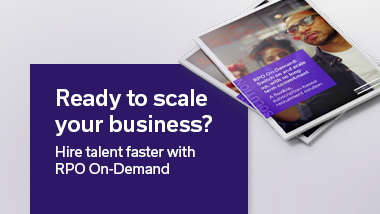Five market conditions that impact workforce planning
The pandemic has shifted the workforce, and also importantly, dramatically changed employee expectations. Today, employers need to consider how to apply flexible work schedules and manage employee safety in the office, while also balancing specific market conditions such as competitor moves and industry changes in a highly-competitive and more digitised market.
There are many market conditions that may call for an opportunity to move to outsourcing – here are five scenarios in particular that you need to look out for when considering an outsourced recruitment model:
Acquisition or Expansion
Are you planning an acquisition or market expansion? This will require a re-assessment of headcount or departmental structure to ensure you have the skills – or start thinking about talent – needed to meet imminent demand. You need to think about your team's capabilities and whether your hire numbers are in line with your expansion. Any good RPO solution enhances processes and helps a business focus on performance metrics, data and visibility, and enables more control to the current in-house recruitment team; thus, aiding the transition your business faces.
Competitor Scaling
Sometimes change is forced upon us from an external source, like a geographic or strategic move of a competitor that pushes an market competition for talent, which can then grow into ongoing concerns that catalyzes a business’ re-evaluation of their employer brand and value proposition. Competitor scaling can be an important indication that you need to reassess your business needs and consider the many ways that outsourcing recruitment will be beneficial to you.
Remote Working
Of course, the market is also changing from the inside as more people determine that a remote working model is preferable to them, either as a business or as individuals. A move to a remote work model by a competitor could have uncovered a need for you to switch to a more innovative sourcing strategy. An RPO provider should bring experience, innovative sourcing ideas and the best sourcing tools to your business.
New Customer Challenges
Are your customers facing new problems that will require you to hire and align new types of talent to assist in solving their problems? An example of this could be a demand for more diversity or increased cybersecurity concerns as more of the workforce turns to remote working. The RPO model is designed to support internal team member roles, enabling them to focus on and drive more high-value strategic activities such as in-demand skills hiring.
Agility
The rapid change in talent conditions may have exposed that you need greater agility to stay ahead of your competition. An RPO provides this agility to an business, enabling it to react more quickly to market changes. This ability to scale in line with changing business needs allows optimal capacity management and productivity within the team.
A disruption in market conditions is often a wake-up call that an innovative sourcing strategy may be needed. To learn more about the market conditions you need to be aware of and how to meet these new challenges, check out our guide to Building a Business Case for Outsourcing your Recruitment.












